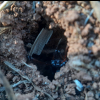Slave raider means they actively seek out other colony's brood and workers. Accepting brood if you give it to them is not the same.
- Formiculture.com
- Forums
- Gallery
- Members
- Member Map
- Chat

Slave raider means they actively seek out other colony's brood and workers. Accepting brood if you give it to them is not the same.
Current Colonies
1 x Camponotus nearcticus (Monogynous), 1 x Crematogaster cerasi (Monogynous), 1 x Formica cf. subsericea (Polygynous Two-Queen), 1 x Formica cf. pallidefulva (Monogynous, single worker),
1 x Lasius cf. americanus (Pleometrotic Founding, now Monogynous), 1 x Tetramorium immigrans (Monogynous)
Current Founding Units
1 x Formica cf. subsericea (Monogynous)
Up-To-Date as of 9/15/2020
Attached in the link is a free PDF on the care of Formica subsericea which will relate to most fully-claustral North-Easter Formica species. Hope this helps! ![]()
https://docs.wixstat...7dbc81eeb8e.pdf
I found two nests in a cemetery the workers were all over it the cemetery so I think it could have been a super colony.
It could also be a satellite nest.
"God made..... all the creatures that move along the ground according to their kinds (including ants). And God saw that it was good. Genesis 1:25 NIV version
Keeping:
Tetramorium immigrans Camponotus vicinus, modoc, novaeboracensis, herculeanus
Formica pallidefulva, argentea Solenopsis molesta
Formica cf. aserva Lasius brevicornis, neoniger
Edited by SolenopsisKeeper-, May 20 2022 - 3:25 PM.
so i see 2 mistakes in the post
1: Formica subsercia ALSO nest in grass and the majority of the nests i found are in the middle of a field, hence the name "silky field ants" and I usually find their nests located in a patch of tall grass that helps them make their famous thatched nests
2: Formica has a higher chance of polygene than other ant species, to prove that I have an colony with 2 queens and in a field I also lifted up a rock that contained 2 queens
Currently keeping:
1x Formica subsericea, 35-40 workers + maybe eggs *New* 2x Camponotus nova, one has only larva
1x Crematogaster cerasi, All workers is ded ![]() *extreme internal screaming* 1x Myrmica ruba sp around 10 workers + pupa
*extreme internal screaming* 1x Myrmica ruba sp around 10 workers + pupa
*New* 1x Temnothorax curvispinosus, 101 or something worker + 3 or 4 royal mom ants + pile of white ant worms
*As you watch your ants march, remember that every thing begins with a small step and continued by diligence and shared dreams* -A.T (which is Me)
Sadly due to unforeseen consequences, I will soon be giving away my colonies (I will miss them though ![]() )
)
Fix the spelling of subsericea.so i see 2 mistakes in the post
1: Formica subsercia ALSO nest in grass and the majority of the nests i found are in the middle of a field, hence the name "silky field ants" and I usually find their nests located in a patch of tall grass that helps them make their famous thatched nests
2: Formica has a higher chance of polygene than other ant species, to prove that I have an colony with 2 queens and in a field I also lifted up a rock that contained 2 queens
sorry I am pretty mixed up with their species name
Currently keeping:
1x Formica subsericea, 35-40 workers + maybe eggs *New* 2x Camponotus nova, one has only larva
1x Crematogaster cerasi, All workers is ded ![]() *extreme internal screaming* 1x Myrmica ruba sp around 10 workers + pupa
*extreme internal screaming* 1x Myrmica ruba sp around 10 workers + pupa
*New* 1x Temnothorax curvispinosus, 101 or something worker + 3 or 4 royal mom ants + pile of white ant worms
*As you watch your ants march, remember that every thing begins with a small step and continued by diligence and shared dreams* -A.T (which is Me)
Sadly due to unforeseen consequences, I will soon be giving away my colonies (I will miss them though ![]() )
)
 |
Ant Keeping →
Ant Keeping Journals →
AntsCzech's general journalStarted by AntsCzech , Oct 18 2025 |
|

|
|
Ant Keeping →
General Ant Keeping →
DeforestationStarted by Idontexist , Oct 1 2025 |
|

|
||
Ant Keeping →
Ant Keeping Journals →
Entomologyants's Dark Rover Ant Journal!Started by Entomologyants , Sep 18 2025 |
|

|
||
Ant Keeping →
Ant Keeping Journals →
Antz_Straya's Australian AntsStarted by Antz_Straya , Sep 7 2025 |
|

|
||
Ants & Myrmecology →
General →
Formica aserva - Founding processStarted by Stubyvast , Aug 21 2025 |
|

|
0 members, 1 guests, 0 anonymous users